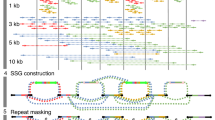Abstract
Paired-read shotgun sequencing of a genome consists of randomly sampling segments of a fixed length, say 10,000 base pairs (10Kbp), and directly determining a “read” of 500 to 700bp at the two ends of each segment with an automated DNA sequencing instrument. Reconstructing or “assembling” a very large genome from such a data set was considered impossible at the time Jim Weber and I proposed it for the Human Genome (2.9Gbp) in 1996. Critics claimed that the computation would involve an impossible amount of computer time, that the size and repetitiveness of the genome would confound all attempts at assembly should sufficient computer efficiency be achieved, and that even if an assembly were produced it would be of an extremely poor quality and partial nature.
Access this chapter
Tax calculation will be finalised at checkout
Purchases are for personal use only
Similar content being viewed by others
Author information
Authors and Affiliations
Editor information
Editors and Affiliations
Rights and permissions
Copyright information
© 2002 Springer-Verlag Berlin Heidelberg
About this paper
Cite this paper
Myers, G. (2002). The Assembly of the Human and Mouse Genomes. In: Ibarra, O.H., Zhang, L. (eds) Computing and Combinatorics. COCOON 2002. Lecture Notes in Computer Science, vol 2387. Springer, Berlin, Heidelberg. https://doi.org/10.1007/3-540-45655-4_1
Download citation
DOI: https://doi.org/10.1007/3-540-45655-4_1
Published:
Publisher Name: Springer, Berlin, Heidelberg
Print ISBN: 978-3-540-43996-7
Online ISBN: 978-3-540-45655-1
eBook Packages: Springer Book Archive




